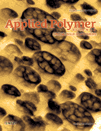A new liquid rubber-assisted dispersion of organoclay in carbon black filled carboxylated acrylonitrile–butadiene rubber matrix
Abstract
A novel route for the preparation of rubber–carbon black–nanoclay (NC) nanocomposites with XNBR as a matrix and a carboxyl-terminated copolymer of butadiene and acrylonitrile (CTBN) as a low-molecular-weight modifier for commercially available NC is presented in this article. The addition of NC to the rubber (after the NC was mixed with CTBN in a 2 : 1 ratio) showed remarkable improvement in the mechanical properties. The clay loading was varied from 0 to 10 parts per hundred rubber (phr). An amount of 20 phr N330 black was incorporated into all of the formulations. The properties were compared with those of a control XNBR compound having only 20 phr N330. X-ray diffraction revealed a combination of a high level of intercalated and exfoliated structures in such nanocomposites. Transmission electron microscopy confirmed the improvement in dispersion as a result of addition of CTBN. A 127% increase in the tensile strength and a 53% increase in the elongation at break were achieved. © 2012 Wiley Periodicals, Inc. J. Appl. Polym. Sci., 2013




